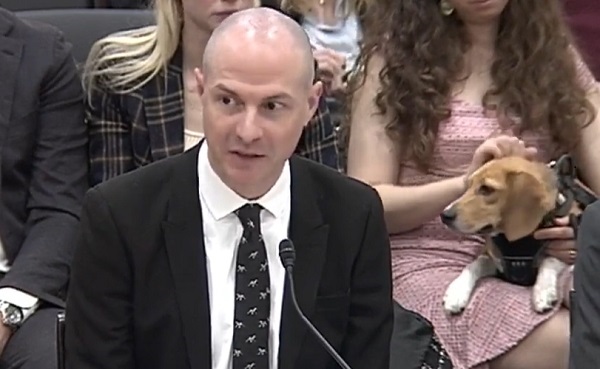Business
Dr. Fauci accused of wasting millions in taxpayer dollars on ‘transgender animal experiments’

From LifeSiteNews
The days of animal testing may be numbered, having been found to be less reliable than other methods of research.
Experts speaking at a Republican-led congressional hearing revealed the shocking news that at least $10 million had been wasted by government health agencies on “transgender animal testing” and that the number was likely closer to a quarter billion dollars or more.
Justin Goodman, senior vice president of the White Coat Waste Project, shed light on the exorbitant waste of American tax dollars on barbaric animal research that has prioritized woke societal trends over scientific outcomes.
“In our analysis, Dr. (Anthony) Fauci funded about 95% of the transgender animal experiments,” Goodman said.
Goodman told members of the Subcommittee on Cybersecurity, Information Technology, and Government Innovation, chaired by Republican Rep. Nancy Mace of South Carolina, that in his estimation $241 million has been spent on transgender animal testing, adding, “I would say that is the floor, not the ceiling because the information on federal databases is pretty incomplete.”
He described the nature of the transgender experimentation inflicted on the animals:
In a lot of these cases, there are involved mice, rats, monkeys who are being surgically mutilated and subjected to hormone therapies to mimic female to male, or male to female gender transitions … gender-affirming hormone therapies, and then looking at the biological, psychological, and physiological effects of the gender transitions, looking at the effects of taking vaccines after you’ve transitioned these animals from male to female or female to male, looking at the size of their genitals changing after you’ve put them on estrogen or testosterone therapies to transition them.
Rep. Mace explained – and Goodman confirmed – that “DEI grants” included “$1.1 million spent to find out if female rats receiving testosterone therapies to mimic transgender men were more likely to overdose on a party drug commonly used in the LGBTQ community to induce drug-fueled ‘chemsex.’”
Goodman said that the reason the public doesn’t know about these sadistic experiments is that “You essentially need a degree in information technology to navigate the federal spending databases to find any of this stuff.”
“It’s by design,” he added.
Fauci’s barbaric animal testing could lead to a new, deadly pandemic
Goodman went on to point his finger squarely at Dr. Fauci and his U.S.-funded virus research at China’s Wuhan lab and warned about dire future public health risks of continuing with outrageous animal studies.
“We’re flirting with disaster if we continue to fund dangerous virus research,” Goodman said, “like in Colorado where Fauci greenlit this bat lab.”
“They’re trying to import hundreds of bats from Asia (and) build a new lab in Colorado to do virus experiments with Ebola, Nipah, Lassa – deadly viruses for which there is no cure,” he explained.
“It’s just a matter of time before we have another pandemic on our hands if we let mad scientists run amok with our money,” Goodman warned.
Most of the 27 NIH institutes and centers conduct or support animal testing – as does the Food and Drug Administration, the U.S. Department of Agriculture, the Department of Veterans’ Affairs, the Department of Defense, and countless agencies.
Mace’s committee reported that the U.S. government spends in excess of $20 billion every year conducting experiments on animals.
The White Coat Waste Project found in 2021 that the National Institute of Allergy and Infectious Diseases, a component of NIH at the time run by Fauci, spent $1.68 million force-feeding toxic drugs to beagle puppies between six and eight months old before dissecting and killing them.
In 2022, due to public criticism lobbied against Fauci’s HIH by me and other members of Congress, another $1.8 million experiment to abuse beagle puppies in various drug tests was cancelled.
The days of animal testing may be numbered, having been found to be less reliable than other methods of research.
“Scientific progress has given us better tools for toxicology and biomedical research, making animal testing increasingly outdated,” said Dr. Paul Locke, a professor at Johns Hopkins Bloomberg School of Public Health who also testified at the hearing.
“Embracing these alternatives is a win-win,” Locke said. “It reduces animal use while providing data that better reflects human health.”
Business
Socialism vs. Capitalism

People criticize capitalism. A recent Axios-Generation poll says, “College students prefer socialism to capitalism.”
Why?
Because they believe absurd myths. Like the claim that the Soviet Union “wasn’t real socialism.”
Socialism guru Noam Chomsky tells students that. He says the Soviet Union “was about as remote from socialism as you could imagine.”
Give me a break.
The Soviets made private business illegal.
If that’s not socialism, I’m not sure what is.
“Socialism means abolishing private property and … replacing it with some form of collective ownership,” explains economist Ben Powell. “The Soviet Union had an abundance of that.”
Socialism always fails. Look at Venezuela, the richest country in Latin America about 40 years ago. Now people there face food shortages, poverty, misery and election outcomes the regime ignores.
But Al Jazeera claims Venezuela’s failure has “little to do with socialism, and a lot to do with poor governance … economic policies have failed to adjust to reality.”
“That’s the nature of socialism!” exclaims Powell. “Economic policies fail to adjust to reality. Economic reality evolves every day. Millions of decentralized entrepreneurs and consumers make fine tuning adjustments.”
Political leaders can’t keep up with that.
Still, pundits and politicians tell people, socialism does work — in Scandinavia.
“Mad Money’s Jim Cramer calls Norway “as socialist as they come!”
This too is nonsense.
“Sweden isn’t socialist,” says Powell. “Volvo is a private company. Restaurants, hotels, they’re privately owned.”
Norway, Denmark and Sweden are all free market economies.
Denmark’s former prime minister was so annoyed with economically ignorant Americans like Bernie Sanders calling Scandanavia “socialist,” he came to America to tell Harvard students that his country “is far from a socialist planned economy. Denmark is a market economy.”
Powell says young people “hear the preaching of socialism, about equality, but they don’t look on what it actually delivers: poverty, starvation, early death.”
For thousands of years, the world had almost no wealth creation. Then, some countries tried capitalism. That changed everything.
“In the last 20 years, we’ve seen more humans escape extreme poverty than any other time in human history, and that’s because of markets,” says Powell.
Capitalism makes poor people richer.
Former Rep. Jamaal Bowman (D-N.Y.) calls capitalism “slavery by another name.”
Rep. Alexandria Ocasio-Cortez (D-N.Y.) claims, “No one ever makes a billion dollars. You take a billion dollars.”
That’s another myth.
People think there’s a fixed amount of money. So when someone gets rich, others lose.
But it’s not true. In a free market, the only way entrepreneurs can get rich is by creating new wealth.
Yes, Steve Jobs pocketed billions, but by creating Apple, he gave the rest of us even more. He invented technology that makes all of us better off.
“I hope that we get 100 new super billionaires,” says economist Dan Mitchell, “because that means 100 new people figured out ways to make the rest of our lives better off.”
Former Labor Secretary Robert Reich advocates the opposite: “Let’s abolish billionaires,” he says.
He misses the most important fact about capitalism: it’s voluntary.
“I’m not giving Jeff Bezos any money unless he’s selling me something that I value more than that money,” says Mitchell.
It’s why under capitalism, the poor and middle class get richer, too.
“The economic pie grows,” says Mitchell. “We are much richer than our grandparents.”
When the media say the “middle class is in decline,” they’re technically right, but they don’t understand why it’s shrinking.
“It’s shrinking because more and more people are moving into upper income quintiles,” says Mitchell. “The rich get richer in a capitalist society. But guess what? The rest of us get richer as well.”
I cover more myths about socialism and capitalism in my new video.
Business
Residents in economically free states reap the rewards

From the Fraser Institute
A report published by the Fraser Institute reaffirms just how much more economically free some states are compared with others. These are places where citizens are allowed to make more of their economic choices. Their taxes are lighter, and their regulatory burdens are easier. The benefits for workers, consumers and businesses have been clear for a long time.
There’s another group of states to watch: “movers” that have become much freer in recent decades. These are states that may not be the freest, but they have been cutting taxes and red tape enough to make a big difference.
How do they fare?
I recently explored this question using 22 years of data from the same Economic Freedom of North America index. The index uses 10 variables encompassing government spending, taxation and labour regulation to assess the degree of economic freedom in each of the 50 states.
Some states, such as New Hampshire, have long topped the list. It’s been in the top five for three decades. With little room to grow, the Granite State’s level of economic freedom hasn’t budged much lately. Others, such as Alaska, have significantly improved economic freedom over the last two decades. Because it started so low, it remains relatively unfree at 43rd out of 50.
Three states—North Carolina, North Dakota and Idaho—have managed to markedly increase and rank highly on economic freedom.
In 2000, North Carolina was the 19th most economically free state in the union. Though its labour market was relatively unhindered by the state’s government, its top marginal income tax rate was America’s ninth-highest, and it spent more money than most states.
From 2013 to 2022, North Carolina reduced its top marginal income tax rate from 7.75 per cent to 4.99 per cent, reduced government employment and allowed the minimum wage to fall relative to per-capita income. By 2022, it had the second-freest labour market in the country and was ninth in overall economic freedom.
North Dakota took a similar path, reducing its 5.54 per cent top income tax rate to 2.9 per cent, scaling back government employment, and lowering its minimum wage to better reflect local incomes. It went from the 27th most economically free state in the union in 2000 to the 10th freest by 2022.
Idaho saw the most significant improvement. The Gem State has steadily improved spending, taxing and labour market freedom, allowing it to rise from the 28th most economically free state in 2000 to the eighth freest in 2022.
We can contrast these three states with a group that has achieved equal and opposite distinction: California, Delaware, New Jersey and Maryland have managed to decrease economic freedom and end up among the least free overall.
What was the result?
The economies of the three liberating states have enjoyed almost twice as much economic growth. Controlling for inflation, North Carolina, North Dakota and Idaho grew an average of 41 per cent since 2010. The four repressors grew by just 24 per cent.
Among liberators, statewide personal income grew 47 per cent from 2010 to 2022. Among repressors, it grew just 26 per cent.
In fact, when it comes to income growth per person, increases in economic freedom seem to matter even more than a state’s overall, long-term level of freedom. Meanwhile, when it comes to population growth, placing highly over longer periods of time matters more.
The liberators are not unique. There’s now a large body of international evidence documenting the freedom-prosperity connection. At the state level, high and growing levels of economic freedom go hand-in-hand with higher levels of income, entrepreneurship, in-migration and income mobility. In economically free states, incomes tend to grow faster at the top and bottom of the income ladder.
These states suffer less poverty, homelessness and food insecurity and may even have marginally happier, more philanthropic and more tolerant populations.
In short, liberation works. Repression doesn’t.
-

 armed forces2 days ago
armed forces2 days agoOttawa’s Newly Released Defence Plan Crosses a Dangerous Line
-

 espionage2 days ago
espionage2 days agoCarney Floor Crossing Raises Counterintelligence Questions aimed at China, Former Senior Mountie Argues
-

 Health2 days ago
Health2 days agoAll 12 Vaccinated vs. Unvaccinated Studies Found the Same Thing: Unvaccinated Children Are Far Healthier
-

 Energy2 days ago
Energy2 days ago75 per cent of Canadians support the construction of new pipelines to the East Coast and British Columbia
-

 Opinion2 days ago
Opinion2 days agoPope Leo XIV’s Christmas night homily
-

 armed forces2 days ago
armed forces2 days agoRemembering Afghanistan and the sacrifices of our military families
-

 Fraser Institute22 hours ago
Fraser Institute22 hours agoCarney government sowing seeds for corruption in Ottawa
-

 Daily Caller22 hours ago
Daily Caller22 hours agoWhile Western Nations Cling to Energy Transition, Pragmatic Nations Produce Energy and Wealth






